Protection and automation terminals based on ABB microprocessors
Functionality, advantages of microprocessor protection terminals compared to electromechanical protection devices
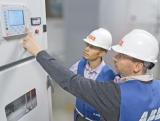 The equipment for switchgear of substations, in particular the outgoing lines feeding consumers or adjacent substations, must be reliably protected from possible damage. Until the 2000s. as protection of substation equipment, exclusively used devices for relay protection and automation of the electromechanical type, which are built on the relay of the electromechanical principle of operation.
The equipment for switchgear of substations, in particular the outgoing lines feeding consumers or adjacent substations, must be reliably protected from possible damage. Until the 2000s. as protection of substation equipment, exclusively used devices for relay protection and automation of the electromechanical type, which are built on the relay of the electromechanical principle of operation.
Now the old electromechanical protections are gradually being replaced by modern devices — microprocessor terminals for protection, control and automation of equipment, which are increasingly common in newly built or technically re-equipped substations.In this article, we will look at the functionality and advantages of microprocessor-based protection terminals, using the REF 630 terminal manufactured by ABB to protect the 35 kV consumer line as an example, we will give a comparative characteristic with their predecessors - electromechanical protections type.
Advantages of modern devices for relay protection and automation
One of the main advantages of microprocessor terminals over old-style protection is their compactness. To implement protection, automation, control of 35 kV network equipment, it is necessary to install a complex chain of many electromechanical relays that barely fit on one relay panel.
In addition, it is necessary to install on each line a switch control switch, switches for selecting operating modes, overlays for switching / disabling automatic devices, meters for fixing the load current on the line - for the listed items there must be another panel is installed.
The microprocessor protection terminal has small overall dimensions.
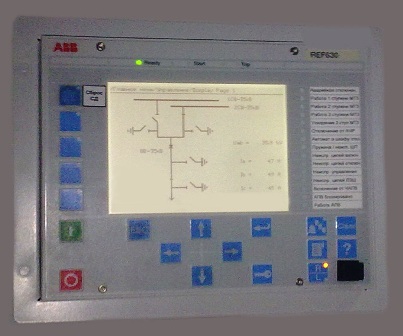
Due to its small overall size, a relay protection and automation panel can accommodate two protection terminals and corresponding switches for controlling circuit breakers on 35 kV lines, as well as for switching different operating modes relay protection devices.
In this example, the protective terminal REF 630 protects the outgoing power line. The terminal also has other standard configurations that allow the terminal to be used to protect a power transformer, section breaker or bus breaker.
The huge advantage of this device is that standard configurations can be adjusted with maximum accuracy for real conditions, take into account all possible nuances and select the desired functions.
As for measuring devices, in the case of using microprocessor terminals, they do not need to be installed, since the display of the protective device shows the phase load of the line, as well as other electrical parameters.
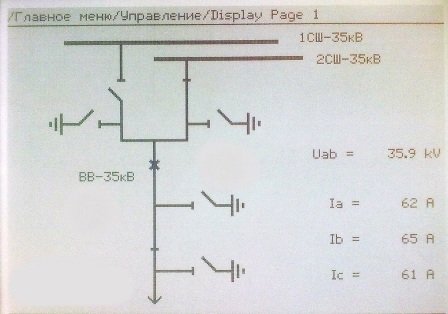
As can be seen in the photo, on the display of the protective terminal, in addition to the load on this line, a mnemonic diagram is displayed showing the actual position of the switching devices: bus disconnectors of 1 and 2 of the 35 kV system bus, vacuum circuit breaker, line disconnector of the connection, as well as the position of stationary earthing devices of bus and line disconnectors. The display also shows the voltage for the bus system from which the line is currently supplied.
If necessary, the protective terminal can be configured to display other measured values (phase voltage, active and reactive components of the load, its directionality, frequency of the electrical network) and indicate different modes of operation (state of the set AR, AR , CHAPV , LZSh).
A significant advantage of microprocessor-based protection is the ease of control over the operation mode of the equipment, including the elimination of emergency situations. On the front panel of the terminal there are LED indicators indicating their names.
In old-style protections, signaling relays, so-called «blinkers», were used to indicate operating modes.In the event of an emergency or deviations from the normal operation of the protective devices, it is necessary to review each of the indicating relays, which very often had an uncomfortable relative position, and each of the relays must return to its initial position (» confirm «) individually.
On the protective terminal, the LEDs are arranged in one column, so it is quite convenient to write down possible deviations - you just need to look at the corresponding terminal. It is also an advantage that to "confirm" the LEDs on the terminal, you simply press a button.
This advantage is most appreciated in the case of a major substation accident, when many protective devices are activated. In this case, it is enough to approach each terminal, fix the position of the LEDs and press the button. For electromechanical protections, it is necessary to spend much more time to fix the position of each indicator relay and return it to its original position, that is, for "confirmation".
Functional characteristics of microprocessor devices for relay protection
If microprocessor devices are used to protect the line, then in the event of disconnection of the breaker from protection or in the case of automatic operation, the time of operation, the name of the activated protection or an element of the automation of the line are recorded in the memory of a device, as well as the electrical parameters in the emergency, emergency and post-emergency periods. Thanks to this functionality, it is possible to accurately restore the picture of what happened, which is very important in case of major accidents, accidents in the energy sector.

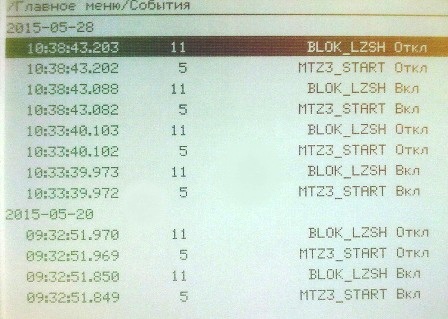
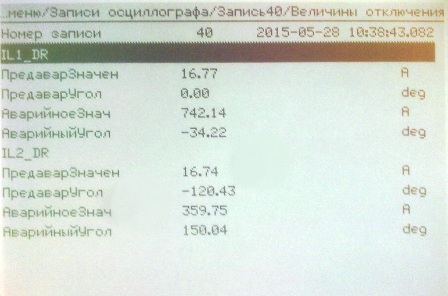
In the picture, you can see that the recording of emergency situations takes place within milliseconds. This allows, when analyzing the operation of the protective devices, to correctly determine the sequence of their action and to draw a conclusion about the correct operation of the protections in accordance with the specified settings and conditions of their operation.
The device allows storage of 1000 event records in non-volatile memory.
The protection terminal has the function of self-diagnosis, control of input and output circuits, which enables timely detection of malfunction. When using electromechanical protection, violations in the operation of protective devices are not signaled, therefore, a violation of their operation is very often detected in the event of improper operation of the protection or complete failure.
As for the security settings, in the microprocessor-based security device, they are changed in the menu by selecting the necessary values. In this case, you can create several groups of settings and quickly switch between them, which is very convenient in case of a need to temporarily change the values of the settings.
Also, one of the advantages of microprocessor terminals is the ability to connect them SCADA system, which allows the substation maintenance staff to monitor the status of the switching devices, the magnitude of the loads and the voltages on the buses; as well as to the ADCS system, which allows not only to control, but also to manage the equipment remotely, from the central control point.
Read also: Microprocessor-based relay protection devices: overview of possibilities and controversial issues
